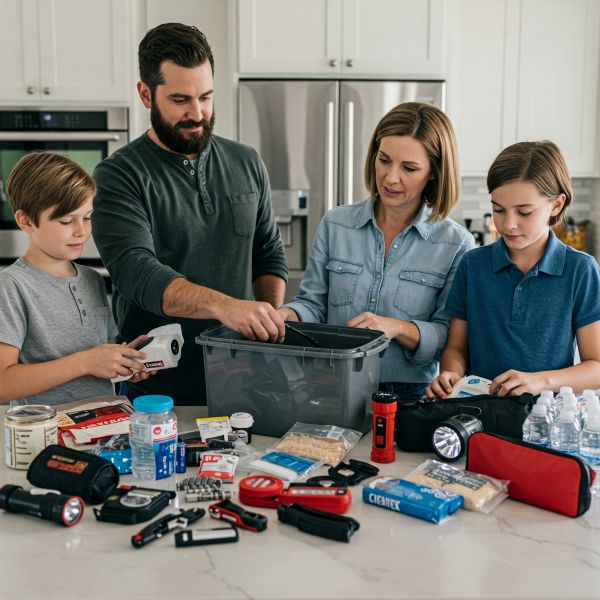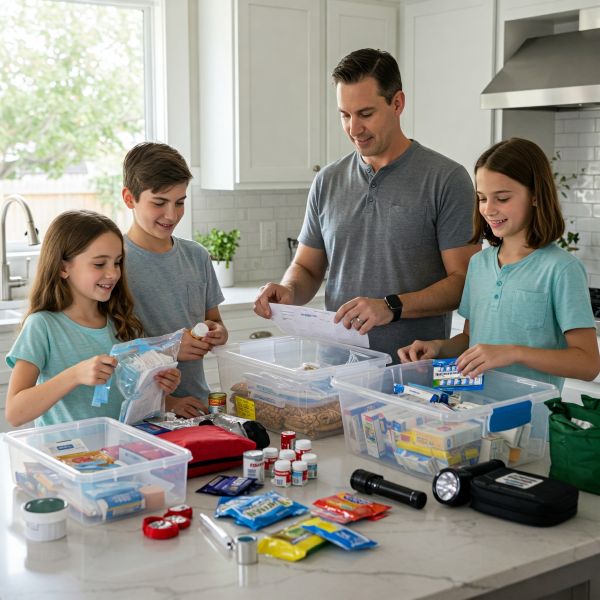How to Create a Home Emergency Preparedness Kit
Be Ready Before Disaster Strikes

Emergencies are the ultimate surprise guests—uninvited and often chaotic. Whether it’s a natural disaster, prolonged power outage, or civil unrest, being unprepared can put you and your loved ones at serious risk.
That’s why creating a home emergency preparedness kit is one of the smartest decisions you can make. It’s not about fear—it’s about being ready when life throws a curveball.
This comprehensive guide will walk you through the essential emergency supplies, long-term considerations, and expert tips to make sure your household can weather any storm. From survival basics to maintaining your kit over time, we’ve got you covered—literally and figuratively.
🛠️ What Is a Home Emergency Preparedness Kit?
A home emergency preparedness kit is a collection of essential items you may need to survive and stay safe during an emergency. Think of it as your lifeline when the usual comforts—like electricity, clean water, or quick access to a grocery store—are no longer available.
Whether you’re facing a flood, wildfire, blizzard, hurricane, or pandemic lockdown, having a well-stocked kit puts you in control of an otherwise uncontrollable situation.
🧰 Core Components of a Home Emergency Kit
Let’s break down the essential supplies every home emergency kit should contain:
🧴 1. Water Supply
- Minimum: One gallon of water per person per day (for at least three days).
- Purpose: Drinking, cooking, hygiene.
- Extra Tip: Add water purification tablets or a portable water filter in case you need to collect water from an unknown source.
💡 Pro tip: Store bottled water in multiple areas of your home—not just in the kitchen—to avoid relying on one access point.
🍲 2. Emergency Food Supply
- Stock: Canned goods, high-protein bars, freeze-dried meals, nuts, dried fruits.
- Duration: At least a 3-day supply, though 2 weeks is ideal.
- Must-Have: Manual can opener (don’t get stuck with cans you can’t open!).
- Consider: Special dietary needs—gluten-free, baby formula, pet food.
🩹 3. First Aid Kit
Every emergency kit needs a robust first-aid kit, including:
- Bandages, gauze, antiseptic wipes
- Pain relievers (acetaminophen, ibuprofen)
- Scissors, tweezers
- Personal prescription medications (7+ day supply)
- First-aid instruction manual
🧠 Don’t forget extra inhalers, insulin, EpiPens, or anything specific to your family’s medical needs.
🔦 4. Lighting and Power
- Flashlight (with extra batteries)
- Headlamps (keep your hands free!)
- Hand-crank or solar-powered lights
- Power banks for phones
- Car charger
📻 5. Emergency Communications
- Battery-powered or hand-crank radio
- NOAA Weather Radio for local alerts
- Backup mobile phone
- Prepaid phone card in case networks go down
🧼 6. Sanitation and Hygiene
- Toilet paper and moist towelettes
- Garbage bags and plastic ties
- Hand sanitizer and soap
- Feminine hygiene products
- Face masks or N95 dust masks
🛠️ 7. Tools and Gear
- Wrench or pliers (to shut off gas or water lines)
- Local area maps (don’t rely on your phone’s GPS)
- Multi-tool or Swiss army knife
- Duct tape (never underestimate it!)
- Fire extinguisher
🧾 8. Personal Items and Documents
- Copies of ID, insurance, birth certificates, medical records
- Emergency contacts printed out
- Maps of your area and evacuation routes
- Some cash in small bills—ATMs may be out of order
🧣 9. Comfort and Warmth
- Blankets or sleeping bags
- Extra clothing (consider seasonal weather)
- Ponchos or raincoats
- Sturdy shoes or boots
🧒 Customizing Your Kit for Family Needs
Every family is different, and your emergency kit should reflect that. Here are some customizations to consider:
- Infants: Diapers, formula, baby wipes, baby medications
- Seniors: Mobility aids, extra glasses, hearing aid batteries
- Pets: Food, water, leashes, pet carriers, waste bags
- Kids: Toys, books, comfort items, games to keep them calm and distracted
🧪 Long-Term Emergency Supplies (For Extended Disasters)
For those who want to go beyond the basics, or who live in high-risk areas (wildfire zones, hurricane paths), it’s worth preparing for 2 weeks or more.
Suggested additions:
- Portable camp stove with fuel
- Generator and fuel (store safely!)
- Extra water (a water drum or rain collection system)
- Sleeping mats or inflatable mattresses
- Solar-powered chargers and lanterns
- Extra masks and gloves for pandemics or dust storms
🧠 Tips for Storing and Maintaining Your Kit
Creating the kit is just step one. Keeping it up-to-date is what ensures it’s actually useful when you need it.
🔁 Routine Maintenance Checklist:
- Check expiration dates on food, water, and medications every 6 months.
- Test flashlights and radios regularly.
- Update important documents as needed.
- Rotate seasonal clothing.
- Review with your family—everyone should know where the kit is and how to use it.
📦 Where to Store Your Emergency Kit
- Main Home Kit: Store in a waterproof container in an easily accessible spot.
- Go-Bags: Pack smaller kits in backpacks for quick evacuations.
- Car Kit: Keep emergency supplies in your trunk, especially in winter.
- Work Kit: A mini version at your desk or locker with food, water, and meds.
🚗 You never know where you’ll be when disaster hits—having kits in multiple locations can be a game changer.
🧭 Emergency Preparedness Plan: Don’t Just Have It, Practice It
Creating a home emergency preparedness kit is only part of the picture. You need an emergency plan that your entire household understands.
Key Elements:
- Designated meeting spots (one nearby, one outside your neighborhood)
- Emergency contact list (in and out of town)
- Evacuation routes
- How to shut off utilities
Practice mock drills twice a year to keep everyone sharp. Emergencies don’t follow a schedule—your preparedness should be second nature.
🛍️ Bonus Tip: Where to Get Emergency Supplies
You can buy premade emergency kits, but building your own often ensures better customization and saves money. Shop at:
- Hardware stores (for tools and lighting)
- Pharmacies (medications and first-aid items)
- Outdoor retailers (camping stoves, water filters)
- Online survival gear stores (look for kits with good reviews)
✅ Final Thoughts: Peace of Mind is Priceless
You can’t control when disaster strikes, but you can control how prepared you are. A well-planned home emergency preparedness kit gives you peace of mind and could save lives. Start small, build over time, and involve your entire household. The best time to prepare was yesterday—the second-best time is right now.
Share this guide with friends, family, and neighbors. The more people prepared, the safer your entire community becomes.
Don’t just hope for the best—prepare for it.

